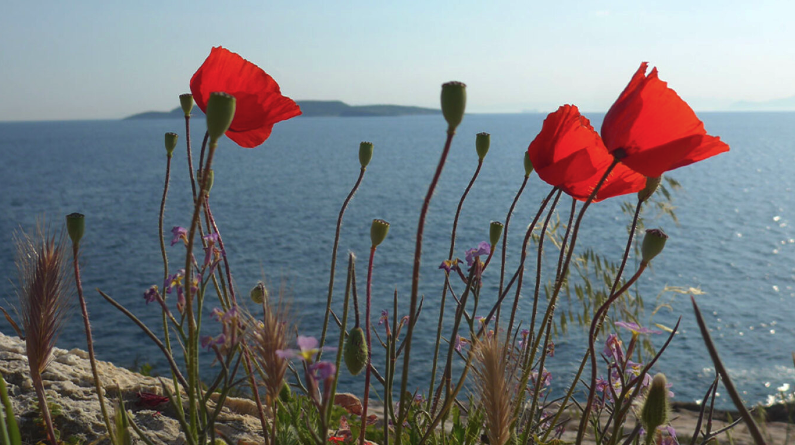Art is almost as old as people, and at our best, we seek to protect and preserve it wherever we find it. The older it is, the more precious it is, because of what it can teach us about people long gone. Hers is a list of the 10 oldest forms of arts known to us.
10. The Oldest Prehistoric Rock Art
290,000–700,000 B.C.

The oldest examples of prehistoric rock art found to date are a form of pictograph that archaeologists call “cupules” (cup-marks), which are sometimes accompanied with linear carved grooves. Cupules are depressions carved into both horizontal and vertical rock, often arranged systematically into rows or columns. They are found on every continent and throughout several time periods. Some aboriginal cultures, such as those of Central Australia for example, still use them today.
The oldest example is found in the Bhimbetka Caves in central India. Because of telling conditions in the cave, at least two of the cupules almost certainly date back to the Lower Paleolithic, and there is evidence that the remaining nine examples all come from a similar period. While the site hasn’t been radiocarbon-dated yet, Acheulian-era artifacts of India are thought to be about as old as similar finds found in Africa and Europe at an astounding 290,000 years old.
A second collection of around 500 cupules from roughly the same period was found in the Daraki-Chattan cave, along with a wealth of early stone tools. Daraki-Chattan is one of the richest sites for cupules in the world.
Some archaeologists argue that cupules shouldn’t be counted as art because they may have had a utilitarian purpose. They may have been used as grinding basins or for ceremonial purposes, as some cultures still use them today. However, as they are one of the most numerous forms of prehistoric carvings and served a wide range of purposes, it is reasonable to believe that at least some served an artistic or aesthetic purpose. Plus, the many cupules found carved into vertical walls are unlikely to be utilitarian.
9. Oldest Sculpture
230,000–800,000 B.C.

The oldest undisputed depiction of the human form is the Venus of Hohle Fels. It is 40,000 years old.
A much older statue, while controversial, has gained a firm claim to authenticity. Discovered in the Golan Heights in Israel, it’s called the Venus of Berekhat Ram. If it is a true sculpture, it is older than the Neanderthals and was probably made by Home erectus.
The figurine was discovered between two layers of volcanic stone and soil, dated between 233,000 and a mind-boggling 800,000 years old. It was once thought to be a stone that just happened to look human. But microscopic analysis by Alexander Marshack has made it clear that human agency was involved. The Venus is thought to have been slightly anthropomorphic to begin with and was elaborated upon with hominid tools. The base shows evidence that it was carved flat, so as to stand upright.
The case for this figure has been further strengthened by similar discoveries throughout the nearby regions, such as the Tan Tan figurine of Morocco (300,000–500,000 years old). Both figures appear to have been used for ceremonial or religious purposes. The Tan Tan figure was painted ochre, a colour often used for ceremonies.
8. Oldest Eggshell Engravings
60,000 B.C.
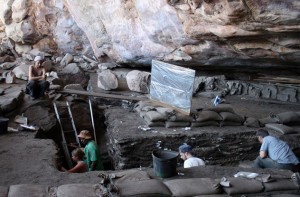
Ostrich shells have been an important tool for many early cultures, and decorating them became an important form of early self-expression for humans.
In 2010, researchers at the Diepkloof Rock Shelter in South Africa discovered a large cache of 270 ostrich egg fragments that bore decorative and symbolic designs, created by the Howiesons Poort hunter-gatherer culture. The fragments were designed using multiple pigments and engraved with hatching motifs. Two different main motifs were recorded: a hatched band and another using sub-parallel or converging lines. Because the patterns changed over time, and because the sample size was at last large enough, archaeologists were able to establish the existence of design traditions among Stone Age cultures, at least as far as engraving is concerned.
There is evidence of enlarged holes carved into the eggshell that shows that the ostrich shells were used as the prehistoric version of water canteens.
7. The Earliest Cave Drawings In Europe 42,300–43,500 B.C.

Until recently, Neanderthals were thought to be incapable of producing artistic works (the recent discovery of decorated stones and shells ended that belief) and were not thought to have created any stone art. That may have changed in 2012, when researchers working in the caves of Nerja in Malaga, Spain discovered drawings that predate the famed Chauvet cave paintings of southeast France by over 10,000 years. Charcoal remains found near six of the paintings were radiocarbon-dated at 42,300–43,500 years old.
The drawings depict seals, a local food item for Neanderthals, which inhabited the region at the time. Project leader Jose Luis Sanchidrian from the University of Cordoba also noted that the drawings lack parallels with other human Paleolithic art and that modern human remains have not been found in the part of the Peninsula that houses the Nerja caves.
6. The Earliest Handprint Paintings 37,900 B.C.
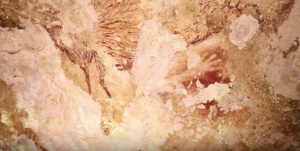
The paintings at the Sulawesi Caves of Indonesia contain one of the oldest representative paintings ever created. At 35,400 years old, they’re nearly as old as several ancient examples of nonrepresentative art, including the older El Castillo Cave Paintings (40,800 years old) and the Chauvet cave paintings (37,000 years old).
But the real kicker of the Sulawesi Caves is a handprint painting, now known to be the oldest ever discovered, at a minimum of 39,900 years old. The stencil was part of a series of 12 painted on the rock face. The age was determined using uranium-series dating of mineral coatings on top of the sediment layer holding the paintings (the paintings themselves could be older). If radiocarbon testing determines that it is older than the sediments, it might also be the oldest painting of any kind ever discovered.
Prehistoric humans blew ochre paint through a tube around the hands to make handprints, a trick still used by children today. All prehistoric art is haunting, but there is something especially haunting about this handprint art. Perhaps it’s the certain knowledge that each one represents a real person who is lost far, far back to the sands of time.
5. Earliest Ivory Carvings 30,000 B.C.
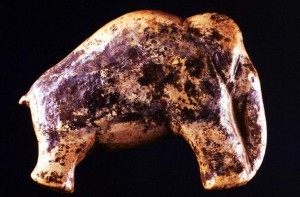
In 2007, archaeologists from the University of Tubingen were working in the Swabian Jura, a plateau in the state of Baden-Wurttemberg in Germany. They discovered a cache of small animal carvings. The carvings date to about 35,000 years ago and are believed to be the first ivory carvings known.
A total of five pieces, carved from mammoth ivory, were found in the Vogelherd Caves in southwestern Germany, a site whose numerous caves have been rich in archaeological discoveries. It was here that archaeologists discovered the famous Lion Man of Hohlenstein Stadel and the Venus of Hohle Fels. Among the discoveries were the remains of a lion figurine, two fragments of a mammoth, and two unidentified figures.
Radiocarbon dating and the geological context of the finds indicate that the carvings were made by the Aurignacian culture, a group associated with modern man’s first arrival in Europe. The tests indicate that they’re 30,000–36,000 years old, with some tests obtaining an even greater age.
Four years earlier, discoverer Nicholas J. Conard reported finding three other figurines in the same region of similar age that included the oldest known representation of a bird, along with a therianthropic (half-human, half-animal) sculpture and a horse-like figure, all over 30,000 years old.
4. The Oldest Ceramic Art 24,000–27,000 B.C.
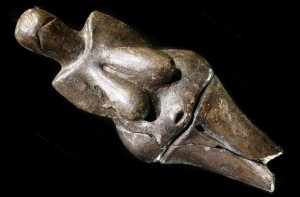
The Venus of Dolni Vestonice is similar to other Venus figurines found throughout the world. It’s an 11.3-centimeter (4.4 in) nude voluptuous female form with large breasts and a protruding bottom, with a head featuring two carved slits for eyes. It is the first known ceramic figure made of a clay body fired at low temperature, and it predates the known usage of fire-baked clay for pottery by 14,000 years. It was excavated on July 13, 1925 in Dolni Vestonice, in South Moravia, Czechoslovakia.
The figure, along with several others and thousands of small fragments, must have been a new technology. Evidence indicates that objects were fired at a low 700 degrees Celsius (1,300 °F), and most pieces showed thermal cracks—including the Venus, which was broken in two when discovered.
The Venus comes from the Gravettian period, 22,000–28,000 years ago. Ceramics didn’t last long for them, as no better ceramics were found afterwards. The pieces seem to be from a period of artistic experiment. The figure has four holes on its head, perhaps to hold flowers or herbs or for some ceremonial purpose.
In 2002, a fingerprint found on the left side of the statue was analyzed and discovered to be that of child 7–15 years old. While the researchers did not conclude that the child actually created the figure, they point to it as evidence of a social aspect to ceramics production in the Gravettian period.
3. The First Known Landscape Painting 6000–8000 B.C.
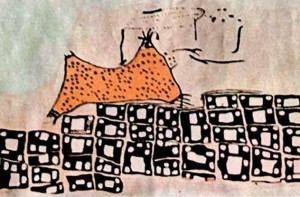
The Catalhoyuk mural, if the controversial claim is true, is the world’s oldest known landscape painting. Or it’s a series of abstract shapes alongside a depiction of a leopard skin. It may be both.
In 1963, archaeologist James Mellaart was working in Catalhoyuk in modern-day Turkey, one of the largest Stone Age towns ever discovered. He discovered one of many murals used to decorate dwellings in the box-shaped homes of the inhabitants. Mellaart believes that the mural depicts a view of the town, with the nearby Hasan Dag volcano erupting overhead. Others contend that the boxes are abstract shapes, and the supposed volcano is a drawing of a leopard skin, since the inhabitants depicted wildlifein many ways. A 2013 study provided some supporting evidence for the landscape hypothesis when it was discovered that the nearby volcano had in fact erupted during the relevant timeframe.
There are two other contenders for the oldest landscape depiction. Both are maps. One, which we’ve reported on previously, is from Western Europe, and the other is called the Pavlov map (24,000–25,000 B.C.). The Catalhoyuk mural doesn’t seem to serve a utilitarian purpose, however, making it the first landscape representation purely for art.
2. The Earliest Christian Illuminated Manuscript A.D. 330–650

In medieval times and before, books were an extremely scarce commodity, rightfully regarded as precious treasures by the few who could obtain them. Perhaps recognizing this, Christian scribes adorned book covers with precious stones and painted the pages with brilliant hues and intricate calligraphy, producing exquisite illuminated manuscripts.
In 2010, in an isolated monastery in the Tigray region of Ethiopia, researchers discovered the Garima Gospels. The early Christian illuminated manuscript was originally thought to have been produced around 1100. But radiocarbon dating revealed that the book was much older, dating from A.D. 330–650 instead, making it the earliest illuminated manuscript ever recovered. It predates others in the region by more than 500 years.
This remarkable book might possibly be linked to the time of Abba Garima, the founder of the monastery where the book was discovered. Legend has it that he wrote the gospels in a single day. To help him with this task, God was said to have stopped the movement of the Sun until he was finished.
Another contender for the title is the Rossano Gospels, from the Cathedral of Rossano in southern Italy. It dates to the sixth century and is viewable online.
1. Oldest Oil Paintings Seventh Century
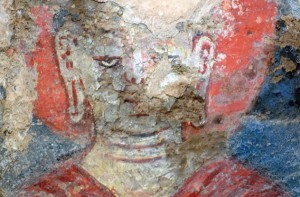
In 2008, a new Buddhist mural and several other works discovered in Afghanistan’s Bamiyan caves showed evidence of an oil-based binder, making them the oldest known oil paintings, predating the Mediterranean or Europe’s use of the medium by at least 100 years. The binder was apparently used to allow the paint to dry upon the rock surface of the caves.
Since 2003, scientists from Japan, Europe, and the US have been working to preserve as much of the artwork in the Bamuian Valley as possible, as part of a project partially funded by UNESCO. They made the discovery while performing chemical tests on some of the paintings. Using gas chromatography and mass spectrometry, scientists discovered that samples from 12 caves and from two giant ruined Buddhas contained oil and resin-based paints.
Dating to about the seventh century, the murals are part of a cave network adorned with paintings that depict Buddhas and mythological figures, along with decorative patterns and swirling ornate designs. Researchers believe that the study of this imagery can provide valuable insights into cultural exchange along the famous Silk Road between people of east and west Asia.
source: listverse.com
































